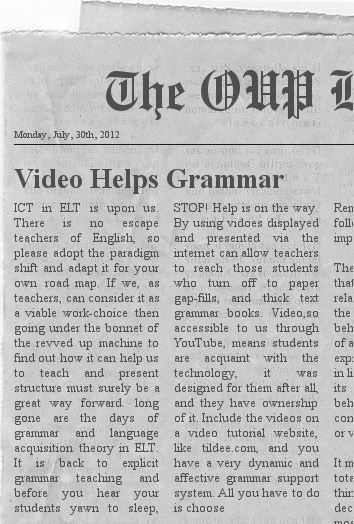
I have been working in Turkey as an ELT practitioner for seventeen years. I became very interested in ICT-ELT two years ago, and began explicitly including it in my syllabus, as a way to further engage Turkish teenage students. At the tail-end of 2010, after having presented on the subject at many conferences, I realised that many of my colleagues were also very interested in the paradigm shift happening in ELT. So, I started to put the ICT-ELT message out to the Turkish provinces. Now after a year of observing teachers, and receiving a great deal of feedback on ICT-ELT, I can see an extraordinary change in people’s attitudes to the exciting possibilities of using technology in (and out of) the classroom.
Since grammar is now having a much welcomed resurgence in popularity with teachers (oh how I despised those, for the most part, years of ‘language acquisition is the only way’ in ELT), I feel it only right to concur with the new focus on grammar, and share a great way for teachers to help make it much more affective for both teachers to present, and for students to enjoy learning the structures they generally find tedious to work at.
I propose that by using video to show how grammar is used in an authentic context, and by having it in the syllabus as both a scaffolding and consolidation stage of understanding structure, students will (and do) engage much more across each form being learned.
I appreciate that the use of video is not new, but I reckon that with it being included under the umbrella of ICT-ELT it has even more effective and affective outcomes.
ICT-ELT
Now that you have seen how easy it is to sign up and use (you don’t have to sign up, but it is better to do so, as you then have your own account where your video tutorials are stored), it is time to see which videos I have used to help students further engage with the process of learning grammar structures.
Note, although I condone video as a means of teaching grammar, I still believe there has to be a balanced mix of traditional and ICT methods if it is to be successful. Yet, even so, it is the ICT-video springboard paradigm that makes it so appealing to students. With this method of presentation and practice, students can re-watch or watch the whole experience at home, or even on their smart phone. It has 24/7 accessibility; thus e-learning, m-learning and total-learning is what we can achieve with this marvellous tool.
Examples of My Tildee Tutorials for Teaching (TTT?) grammar through video:
An Ode to CAN Used to/ Didn’t Use to Star Wars: It’s Present & Simple
Now that you have seen examples of my Tildee tutorials, I’d like to share another video feed-forward to show you how easy it is to add grammar content and videos from YouTube (only YouTube btw for now) to the website:
Video Feed-Forward: How to add vids, text and pics on Tildee
I hope you find the tutorials useful for your students. If you like the style, please contact me and ask for some more. I will email you the links. However, I reckon, once you get the hang of it, you will want to make your own from your own favourite films.
Read David’s own blog at www.davidmearns.blogspot.com.